White light emitting diodes (WLEDs) have been widely used, mainly because WLEDs can be used to provide backlights for portable electronic product displays. It is generally believed that a single WLED requires a driving voltage of 4 volts. Since lithium batteries provide a voltage of 3.6 volts, the industry generally believes that a step-up converter is required to power a WLED with a single lithium battery, so many ICs Can be used to drive WLED, most of which require external inductors or flying capacitors (Flying Capacitor), in order to boost the battery power to a sufficient voltage.
As WLED technology matures, the demand for forward voltage is gradually reduced. At present, the general forward voltage (VF) of many LEDs ranges from 3.2 to 3.5 volts, and the maximum range is from 3.7 to 4 volts. Datasheets usually indicate such voltages for LED currents of approximately 15-25 mA. This article discusses the application of lower currents and how these applications affect the forward voltage of WLEDs. The article also uses Texas Instruments' new LED driver TPS75105 as an example to illustrate how to drive these lower voltages with a smaller size and lower cost. Voltage LED.
Discrimination and analysis of WLED application forward voltage through IV curve
WLED is similar to other standard pn junction diodes and must have sufficient forward voltage to conduct electricity. When the voltage exceeds the critical value, the forward current of the WLED is increased by the forward voltage of the WLED. Figure 1 shows the general IV curve of two WLEDs.
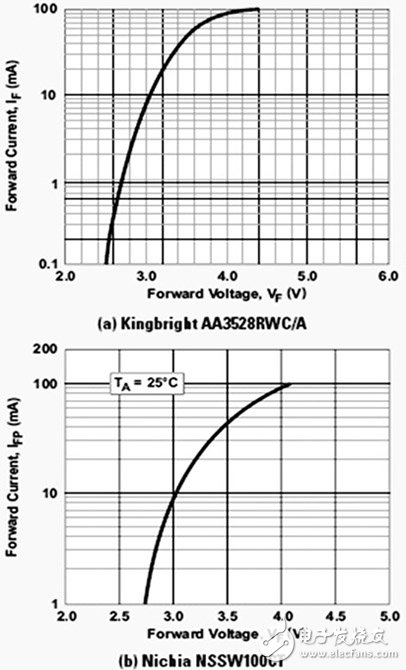
Figure 1 General WLED IV curve
It is quite easy to interpret this picture. On the IV curve of a general diode, when the voltage exceeds a critical value, the current will rise sharply with the voltage. Figure 1a shows that the general forward voltage of the device is specified as 3.2 volts, the forward current is 20 milliamperes, and the maximum 3.7 volts appear during processing and temperature changes. It can be seen from the application that the step-up DC-DC converter is required for the application to drive the WLED with a 3 to 4.2 volt output from a single lithium battery. However, this is not the case. Taking the application of a 5 mA WLED current as an example, the curve in Figure 1a shows that the forward voltage required to drive 5 mA is approximately 2.9 volts, which is much lower than the general voltage required to drive 20 mA as shown in the data sheet. Therefore, only A 3.6 volt lithium battery can be used to drive a 2.9 volt output voltage without a boost converter at all.
The specifications of WLED cover the general values ​​and maximum values ​​of the procedures and production changes between batches. The IV curve provided by the data sheet is usually the case where the component meets the general specifications. Although the shape of the curve is valid for each part produced, it depends on the individual device. Test conditions, the curve will be right or left. If other LEDs with the same part number in the previous example are used, the forward voltage measured under normal test conditions (20 milliampere forward current) is 3.7 volts (rated upper limit), which is 0.5 volts higher than the average device, which means A maximum forward voltage of 3.4 volts (2.9 volts plus 0.5 volts) is required to drive this WLED at 5 milliamps. Depending on the cut-off voltage of the application, this special WLED can be driven at 5 mA without using a boost converter. This technique can be used to determine the maximum forward voltage of any application.
Temperature changes affect LED characteristics
Some applications require WLED to operate in a severe environment with extreme temperatures. Temperature changes will affect the LED characteristics, but the impact on low and high currents is not very strong. The graph from the general WLED data sheet in Figure 2 shows the relationship between forward voltage and temperature.
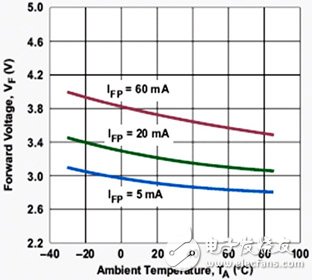
Figure 2 Relationship between forward voltage and temperature (Nichia NSSW100CT)
This graph shows that the temperature dependence becomes more pronounced as the current and forward voltage increase. In addition, once the temperature rises, the forward voltage will decrease. The 5 milliampere curve shows that when changing from room temperature (25 ° C) to the rated upper limit temperature (85 ° C), the forward voltage is reduced by approximately 0.1 volt. When determining the required forward voltage, this should be taken into consideration, but the impact Not very obvious. If a specific application requires driving the LED in an extremely cold environment, the increase in forward voltage will reduce the brightness of the low input voltage.
Realize extremely small LED driver solutions
The general method of driving multiple WLEDs is to connect these WLEDs in series, and then use an inductive boost converter or charge pump to drive the series in series. This is an excellent method for higher WLED currents that require higher forward voltages. However, as mentioned earlier, not all WLED driver applications require a boost converter. The simpler and lower cost driver for low current WLED applications is the extremely small TPS75105 LED driver IC.
The TPS75105 is a linear power supply and contains a very low 28 mV leakage voltage. It is suitable for driving four parallel WLEDs divided into individual two groups. This device provides four 2% matching current paths in the two groups that are individually activated. The 9-ball 1.5-square-millimeter wafer-level cubic size package (WCSP) can use the preset current output without any external components, so the volume is reduced to 1.5 square millimeters. Figure 3 shows the application circuit of TPS75105.
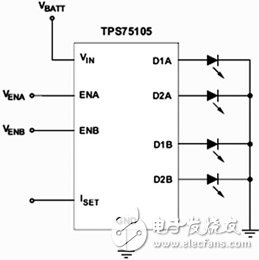
Figure 3 TPS75105 application circuit
At first glance, the use of low-leakage linear circuits seems impractical, because linear regulators (LDOs) have always had problems with poor performance. In fact, there are generally misunderstandings about LDOs. The efficiency of LDOs is entirely determined by the input / output voltage ratio, so the efficiency of driving WLEDs is quite high. For example, driving a 3 volt WLED with an input power of 3.6 volt lithium battery can achieve 83% LED effectiveness. Figure 4 shows the TPS75105 performance of a variety of different WLED forward voltages in the lithium battery range. TPS75105's LED efficiency is no less than or even better than other WLED driver solutions.

Figure 4 TPS75105 LED efficiency
Figure 5 shows the efficiency of the TPS7510x LED on the discharge curve of a lithium battery. In all three curves, the average efficiency of the entire discharge range exceeds 80%, and reaches 90% when the WLED is 3.3 volts. Because this article focuses on low-current applications, the TPS7510x can achieve individual LEDs up to 25 mA as long as the input voltage is sufficient. These applications have the advantage of extremely small size.
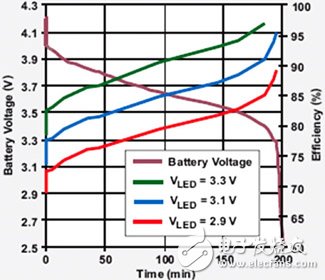
Figure 5 TPS7510x LED efficiency on the discharge curve of a lithium battery
When evaluating LED driver applications, special consideration must be given to how much current the application requires. If the current required is much lower than the current applied to the WLED forward voltage (VF) specification, the IV curve of the WLED data sheet must be checked to determine the actual VF applied. This application can use a low-leakage linear power supply such as TPS75105 to reduce size and cost without compromising the efficiency of switching boost converters.
Led Spot Light is a typical no main light, no fixed size of a modern genres lighting, interior lighting can create the atmosphere, if a row of small led Spot Light combine light energy changes fantastic patterns. Due to the small Spot Light can freely change the angle, the effect of a combination of lighting is also changing,like dim to warm par light. Spot light, soft, elegant, led Spot Light can also be local lighting, heighten the atmosphere.
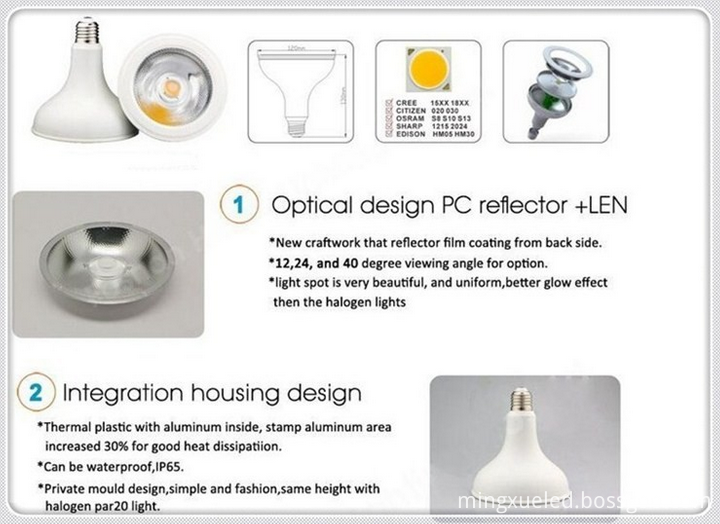
Features:
Led Spot Light can be placed around the ceiling or the upper furniture, can also be placed in the wall, skirt or skirting. Light directly on the need to emphasize the objects on the home to highlight the subjective aesthetic effect, to highlight the unique environment, rich layers, the atmosphere rich, colorful artistic effect. led Spot Light soft, elegant, can play a leading role in the overall lighting, but also local lighting, contrast atmosphere.
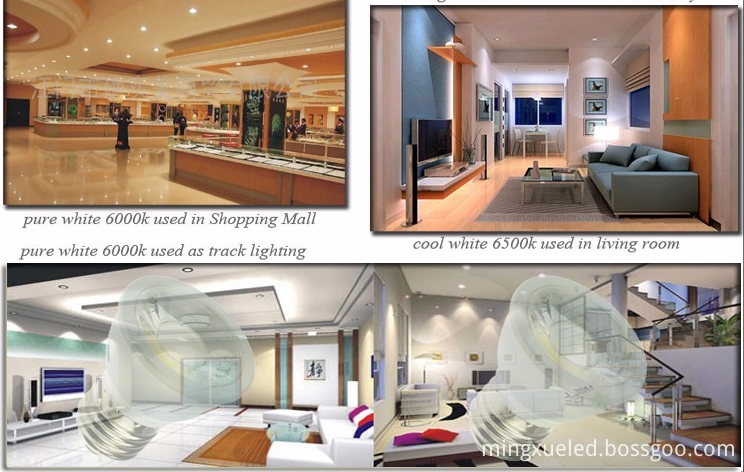
Led Spot Light Function:
1) Save energy: The same power LED lamp power consumption is only 10% of incandescent, but also energy than fluorescent.
2) Long life span: LED lamp beads can work 50,000 hours, than fluorescent lamps and incandescent lamps are long.
3) Dimmable: Previous dimmers have been for incandescent, incandescent light dimming red; difficult to see fluorescent dimmers, which is dimming technology for many years did not develop the main reason; now the LED can dim , And whether it is light or dark light is the same color (color temperature basically unchanged), which is significantly better than incandescent dimming.
4) Low calorific value: Like led Spot Light, a lot of 220V spot with a few days is not broken because of fever. 12V halogen spotlights, although the heat is lower than the 220V spotlights, but there are due to lack of power and other reasons with the transformer, the brightness of less than the nominal value. With LED lighting, no transformer can work for a long time.
Mingxue Optoelectronics Co.,Ltd. has apply the I S O 9 0 0 1: 2 0 0 8 international quality management system certificate, we apply the CE, RoHS and SAA certificate for our led lighting product.


led Spot Light
Led Spot Light,Ar111 13W/10W Dim Spotlight,Ar70 7W Dim Spotlight,Ar70 6W Non-Dim Spot Light
Shenzhen Mingxue Optoelectronics CO.,Ltd , https://www.led-lamp-china.com